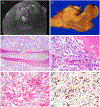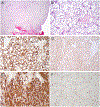TFE3 -Rearranged PEComa/PEComa-like Neoplasms : Report of 25 New Cases Expanding the Clinicopathologic Spectrum and Highlighting its Association With Prior Exposure to Chemotherapy
- PMID: 38597260
- PMCID: PMC11189753
- DOI: 10.1097/PAS.0000000000002218
TFE3 -Rearranged PEComa/PEComa-like Neoplasms : Report of 25 New Cases Expanding the Clinicopathologic Spectrum and Highlighting its Association With Prior Exposure to Chemotherapy
Abstract
Since their original description as a distinctive neoplastic entity, ~50 TFE3 -rearranged perivascular epithelioid cell tumors (PEComas) have been reported. We herein report 25 new TFE3 -rearranged PEComas and review the published literature to further investigate their clinicopathologic spectrum. Notably, 5 of the 25 cases were associated with a prior history of chemotherapy treatment for cancer. This is in keeping with prior reports, based mainly on small case series, with overall 11% of TFE3 -rearranged PEComas being diagnosed postchemotherapy. The median age of our cohort was 38 years. Most neoplasms demonstrated characteristic features such as nested architecture, epithelioid cytology, HMB45 positive, and muscle marker negative immunophenotype. SFPQ was the most common TFE3 fusion partner present in half of the cases, followed by ASPSCR1 and NONO genes. Four of 7 cases in our cohort with meaningful follow-up presented with or developed systemic metastasis, while over half of the reported cases either recurred locally, metastasized, or caused patient death. Follow-up for the remaining cases was limited (median 18.5 months), suggesting that the prognosis may be worse. Size, mitotic activity, and necrosis were correlated with aggressive behavior. There is little evidence that treatment with MTOR inhibitors, which are beneficial against TSC -mutated PEComas, is effective against TFE3 -rearranged PEComas: only one of 6 reported cases demonstrated disease stabilization. As co-expression of melanocytic and muscle markers, a hallmark of conventional TSC -mutated PEComa is uncommon in the spectrum of TFE3 -rearranged PEComa, an alternative terminology may be more appropriate, such as " TFE3 -rearranged PEComa-like neoplasms," highlighting their distinctive morphologic features and therapeutic implications.
Copyright © 2024 Wolters Kluwer Health, Inc. All rights reserved.
Conflict of interest statement
Conflicts of Interest and Source of Funding: The authors have disclosed that they have no significant relationships with, or financial interest in, any commercial companies pertaining to this article.
Figures






References
-
- Ladanyi M, Lui MY, Antonescu CR, et al. The der(17)t(X;17)(p11;q25) of human alveolar soft part sarcoma fuses the TFE3 transcription factor gene to ASPL, a novel gene at 17q25. Oncogene. 2001;20:48–57. - PubMed
-
- Argani P, Antonescu CR, Couturier J, et al. PRCC-TFE3 renal carcinomas: morphologic, immunohistochemical, ultrastructural, and molecular analysis of an entity associated with the t(X;1)(p11.2;q21). Am J Surg Pathol. 2002;26:1553–1566. - PubMed
-
- Clark J, Lu YJ, Sidhar SK, et al. Fusion of splicing factor genes PSF and NonO (p54nrb) to the TFE3 gene in papillary renal cell carcinoma. Oncogene. 1997;15:2233–2239. - PubMed
Publication types
MeSH terms
Substances
Grants and funding
LinkOut - more resources
Full Text Sources
Research Materials
Miscellaneous

